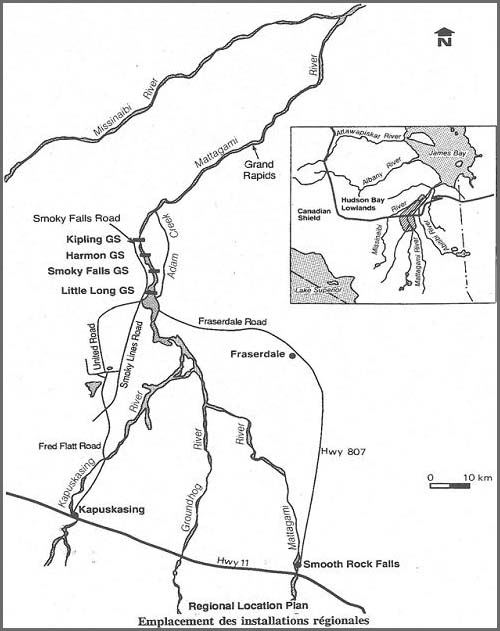
Ontario Power Generation has a mandate from its sole shareholder, the Province of Ontario, to "expand, develop and/or improve its hydroelectric generation capacity" within the province. There are three proposed hydroelectric developments/re-developments on the Mattagami River within the Moose River Basin. The projects are the Lower Mattagami River Project, The Upper Mattagami River Re-development Project, and a new Hydroelectric Development at the Mattagami Lake Dam. The map below shows the location of the Lower Mattagami stations.
The terms upper and lower refer to flow of the river, the upper being the area "up-river" near Timmins, the lower being the area "down river" near James Bay.
Each of these projects will bring more clean, renewable, hydroelectric energy to Ontario helping to reduce our carbon footprint while improving our efficiency in use of existing waterpower resources.
Project information
 The Lower Mattagami River project will allow a significant amount of new energy to be produced without creating new dams on other rivers. In addition to the electricity that will be provided, new development on the Lower Mattagami offers the potential for a commercial relationship with First Nations.
The Lower Mattagami River project will allow a significant amount of new energy to be produced without creating new dams on other rivers. In addition to the electricity that will be provided, new development on the Lower Mattagami offers the potential for a commercial relationship with First Nations.
OPG received Provincial Environmental Assessment (EA) approvals to proceed with the Lower Mattagami Project and is in the process of securing Federal Approvals under the Canadian Environmental Assessment ACT (CEAA).
The Lower Mattagami Hydroelectric Complex is made up of four generating stations on the Mattagami River. The four stations are (from south to north): Little Long, Smoky Falls, Harmon, and Kipling. They are about 70 kilometers northeast of Kapuskasing and about 150 kilometers upstream of Moose Factory and the Town of Moosonee. Smoky Falls was built in 1931 and right now it has a size of about 50 megawatts. One megawatt produces enough electricity for almost 1,000 homes. This station is older and smaller than the others and does can not make effective use of the water passed through by the other three plants. OPG wants to replace it with a generating station that could use all of the available water efficiently. This would mean building a new generating station next to the old one. There would be new manmade structures such as an approach channel, intake and tailrace. The new generating station would be able to pass more water and would have a size of 250 megawatts. The original dams and spillways for the station would remain. Little Long, Harmon and Kipling were all built in the mid-1960s. Each station has two generators to make electricity. Little Long has a size of 135 megawatts. Harmon is 140 megawatts and Kipling is 155 megawatts.
Since the proposed new Smoky Falls dam would now be able to use more water efficiently, OPG is also intends to add a third generator to each of the three existing generating stations. Then the stations could use available water with the best possible efficiently and produce more electricity passing the same volume through each facility. Little Long would then have a size of 200 megawatts. Harmon and Kipling would each be about 240 megawatts. Together the whole project would add nearly 450 MW of capacity to the provincial system and make even better use of an existing resource.
Once construction work is started it is estimated that it would take about four years to complete all the work with a peak work force of about 600 people.
DISCLAIMER: Please note this website was only actively maintained during the related EA process period. As this process may have closed several years ago, the content of this site may not accurately reflect the current date and may include language with incorrect time references.


